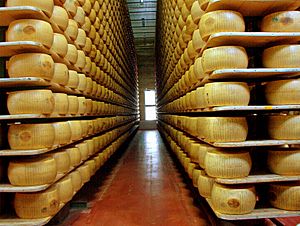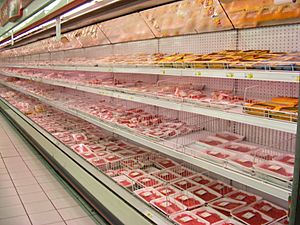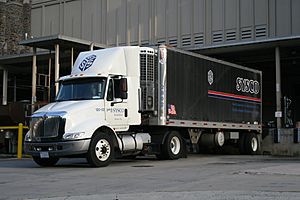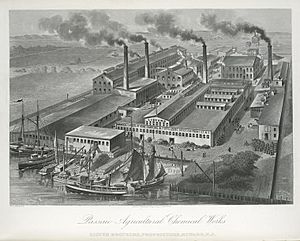Food industry facts for kids
The food industry is a huge, worldwide system of different businesses. It provides most of the food eaten by people all over the world. Today, the food industry is very diverse. It includes small, traditional, family-run businesses that use a lot of human effort. It also has large, modern factories that use many machines. Many food industries rely on local farms, animal farms, fresh produce, or fishing.
It's tricky to describe every part of how food is made and sold. The UK Food Standards Agency says it covers "the whole food industry – from farming and food production, packaging and distribution, to retail and catering." The USDA's Economic Research Service calls it the food system. They say it's "a complex network of farmers and the industries that link to them."
The food industry includes:
- Agriculture: This is about growing crops, raising animals, and catching seafood.
- Manufacturing: This involves making farm equipment, chemicals for farms, and seeds.
- Food processing: This is preparing fresh products for sale and making ready-to-eat foods.
- Marketing: This means promoting food products, advertising, and packaging.
- Wholesale and food distribution: This covers moving food, transportation, and storing it in warehouses.
- Foodservice: This includes restaurants and catering.
- Retail: This is where you buy food, like grocery stores and farmers' markets.
- Regulation: These are the rules and laws for making and selling food, covering safety and quality.
- Education: This includes learning about food science and farming.
- Research and development: This is where new ideas for food science and technology are created.
- Financial services: This includes loans and insurance for food businesses.
Only people who grow all their own food (subsistence farmers) or those who hunt and gather are outside this modern food industry. The biggest companies in the food industry are sometimes called "Big Food."
Contents
Food production
Most food for the industry comes from common crops grown using regular farming methods. Agriculture is how we produce food, animal feed, and other products. This is done by growing plants and raising farm animals. About 83% of the food humans eat comes from land farming. Other food sources include fish farming (aquaculture) and fishing.
Scientists and inventors who work to improve farming are also part of agriculture. One in three people worldwide work in agriculture. However, it only makes up 3% of the world's total economy. In 2017, farming added about 4% to countries' economies on average. Global farming causes between 14% and 28% of greenhouse gas emissions. This makes it a big reason for global warming. This is partly due to common farming practices, like using nitrogen fertilizers and poor land management.
Agronomy is the science of growing and using plants for food, fuel, and other materials. It also helps fix damaged land. Agronomy includes studying plant genetics, plant growth, weather, and soil. Agronomists today work on many issues. These include producing food, making healthier food, managing how farming affects the environment, and getting energy from plants.
Food processing
Food processing involves methods and techniques to turn raw ingredients into food we can eat. It takes clean, harvested, or butchered parts and uses them to make food products ready for sale. There are different ways food can be produced.
One-off production: This is used when customers order something made exactly to their wishes, like a wedding cake. Making these special items can take days, depending on how detailed the design is.
Batch production: This method is used when the demand for a product isn't clear, or when there are many types of one product. A certain number of the same items are made at once, like a bakery baking a limited number of cupcakes. This method involves guessing how much customers will want.
Mass production: This method is used when many identical products are needed for a huge market. Examples include chocolate bars, ready meals, and canned food. The product moves from one step to the next along a production line.
Just-in-time (JIT) production: This method is mostly used in restaurants. All parts of the product are ready in the kitchen. The customer chooses what they want, and it's prepared right away. This happens in sandwich shops, pizzerias, and sushi bars.
Industry influence
The food industry greatly influences what people buy. Groups like The American Academy of Family Physicians (AAFP) have been criticized for taking money from food companies, like Coca-Cola. Critics say these donations can create a conflict of interest, where financial gains might be favored over other concerns.
Criticism
Media
Many books, films, TV shows, and websites have looked closely at and criticized the food industry. Some examples include:
- Eat This, Not That (a series of nonfiction books)
- Fast Food Nation (a 2001 nonfiction book)
- Chew On This (a 2005 book for younger readers based on Fast Food Nation)
- Fast Food Nation (a 2006 documentary film)
- Food, Inc. (a 2008 documentary film)
- Panic Nation (a 2006 nonfiction book)
- Super Size Me (a 2004 documentary film)
- Forks over Knives (a 2011 documentary film)
- The Jungle (a 1906 novel by Upton Sinclair that showed unhealthy practices in American meat factories)
Corporate Influence
Big global organizations, like the World Bank, play a large part in how the food industry works today. After World War II, these groups aimed to help rebuild countries and stabilize economies. Over time, the World Bank started giving loans that tied countries, especially poorer ones, to Western economies. Many countries struggled to pay back these loans. This led to more global debt and the downfall of local economies. As a result, many small farmers have lost their land. Large US companies have bought land in other countries and gained control over food production. Today, several big international companies have pushed new farming technologies on developing countries. These include better seeds, chemical fertilizers, and pesticides.
Policy
In 2020, scientists said that reducing pollution from the global food system is key to reaching the Paris Agreement's climate goals. An EU review in 2020 found that without big changes, pollution would rise by 30–40% by 2050. This is due to more people and changing eating habits. The report said the environmental cost of food production is about $12 trillion per year. It could go up to $16 trillion by 2050. Reports from the IPCC and the EU concluded that changing the food system to reduce greenhouse gases and ensure food security, while moving to sustainable diets, is possible.
Regulation
Since World War II, farming and the food system in the United States have focused on making money. This has sometimes been at the cost of social and environmental well-being. Rules and laws exist to protect consumers. They also try to balance making money with public interests like food quality, safety, animal welfare, and protecting the environment.
Proactive guidance
In 2020, researchers studied how policies could change where, how, and what food is produced. They looked at how policies affect specific regions or nations. For example, reducing meat production and eating less meat, cutting down on food waste, increasing crop yields, and planning land use internationally. They found that increasing farm yields helps protect nature in Africa. Also, changes in diets are very helpful in North America. They concluded that global teamwork and quick action are needed.
Wholesale and distribution
A huge global network of trucks, ships, and planes connects all parts of the food industry. This includes suppliers, factories, warehouses, stores, and customers. Wholesale markets for fresh food have become less important in cities. This is because supermarkets buy directly from farmers or special suppliers, instead of going through markets.
Keeping food flowing smoothly from distribution centers to stores is very important for the food industry. Distribution centers work better, move more products, lower costs, and use workers more wisely if they set up their storage and moving systems correctly.
Retail
As more people live in cities worldwide, buying food is increasingly separate from growing food. In the 20th century, the supermarket became the main place to buy food. There, tens of thousands of products are gathered in one place, available all year round.
How food is prepared has also changed a lot recently. Today, two parts of the food industry compete for your food money. The grocery industry sells fresh and raw products for you to cook at home. The food service industry, however, offers prepared food. This can be fully cooked meals or partly prepared items for you to finish. Restaurants, cafes, bakeries, and food trucks all offer places for people to buy food.
In the 21st century, online grocery stores appeared. Digital tools for community-supported agriculture have also allowed farmers to sell produce directly. Some online grocery stores have even set social goals beyond just making a profit.
Food industry technologies
Modern food production uses advanced technologies. These include many areas. Farm machines, especially the tractor, have almost removed human labor from many parts of production. Biotechnology is causing many changes in areas like farm chemicals, plant breeding, and food processing. Many other types of technology are also involved. Computer technology is also a key force. Besides these, a few more modern technologies can help improve the industry: robotics and automation, blockchain, nanotech, 3D printing, artificial intelligence, and smart farming. These new technologies can improve the industry in the following ways:
- Robotics and automation: Robots and automated systems are used to package, sort, and check the quality of food. This lowers labor costs and makes things more efficient. These technologies also reduce the chance of food getting dirty because there's less human contact.
- Blockchain: Blockchain technology helps make food safer by showing every step in the supply chain. This technology allows real-time tracking of food products, from the farm to your table. This helps find any safety problems quickly and allows for fast action.
- Nanotechnology: Nanotechnology is used to create new packaging materials. These can make food last longer and reduce food waste. These materials can also be designed to break down naturally, which is better for the environment.
- 3D printing: 3D printing is used to create custom food products and make food production more efficient. With 3D printing, you can make complex shapes and designs that would be hard to do with old manufacturing methods.
- Artificial intelligence (AI): AI is used to look at huge amounts of data in the food industry. This helps find trends and patterns. This technology can make processes better and improve the quality and safety of food products.
- Smart farming: Smart farming uses sensors and data analysis to get better crop yields and reduce waste. This technology helps farmers make smarter choices about when to plant, water, and harvest crops. This makes farming more efficient and sustainable.
Marketing
As people become more removed from how food is made, product creation, advertising, and publicity become the main ways they learn about food. With processed food being the main type, marketers have endless ways to create new products. Of the food advertised to children on TV, 73% is fast food or convenience foods.
One of the biggest challenges in food marketing is the high level of competition. Companies must stand out from others by offering unique products or using new marketing ideas. For example, many food companies now use social media to promote their products and talk with customers.
Another important part of food marketing is understanding what customers like and want. This includes things like age, gender, income, and cultural background. Companies must also know about changing customer trends and change their marketing plans to match.
Labor and education
Until about 100 years ago, farming required a lot of human work. Farming was a common job, and millions of people were involved in making food. Farmers, often taught by their parents, continued the family business. That has changed a lot today. In America in 1870, 70–80% of the population worked in farming. As of 2021, less than 2% of the population works directly in agriculture, and about 83% of people live in cities.
See also
 In Spanish: Industria alimentaria para niños
In Spanish: Industria alimentaria para niños
- Agroindustry
- Agricultural expansion
- Dietary supplement
- Factory farming
- Food fortification, also called Nutrification
- Geography of food
- Local food
- Ultra-processed food









